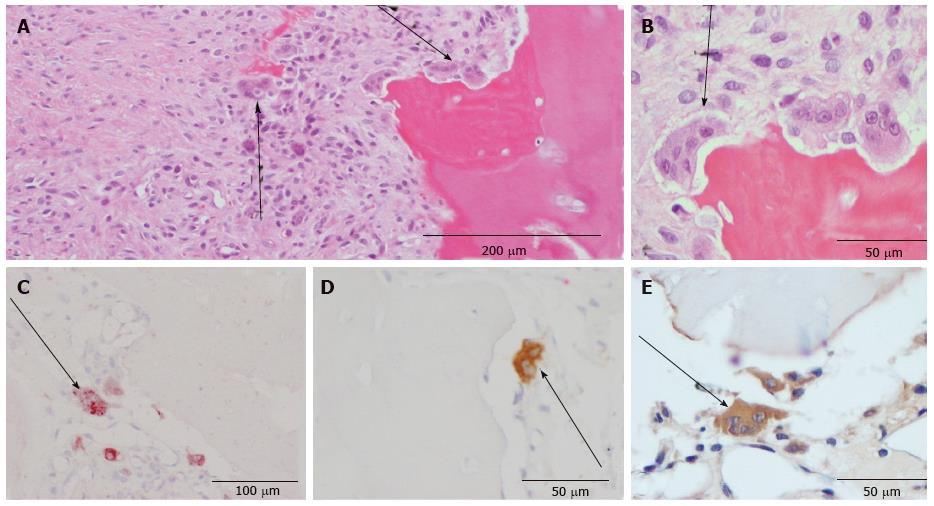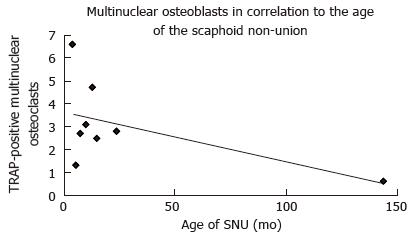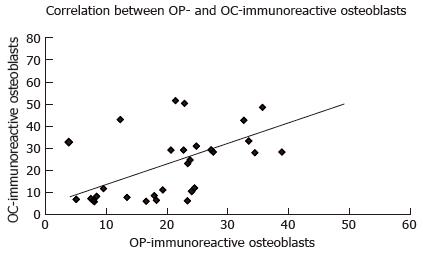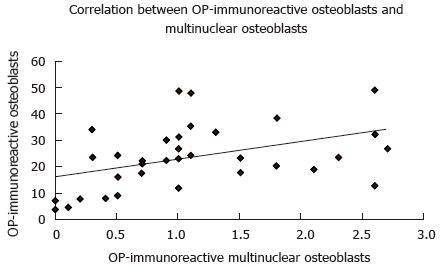Copyright
©The Author(s) 2016.
World J Orthop. Jul 18, 2016; 7(7): 418-425
Published online Jul 18, 2016. doi: 10.5312/wjo.v7.i7.418
Published online Jul 18, 2016. doi: 10.5312/wjo.v7.i7.418
Figure 1 Morphological analysis.
A 7-mo-old SNU is shown (A-C). A: HE-staining shows osteoblasts (black arrow) and osteocytes (white arrow) in the underlying sclerosed bone; B: OC-staining shows osteocytes (arrow) in detail; C: OP-staining shows the osteoblasts (arrow) lining a Haversian vessel in detail. Original magnification 200 × (A, B), 400 × (C). SNU: Scaphoid non-unions; OP: Osteopontin; OC: Osteocalcin.
Figure 2 Osteoclasts.
Examples for multinuclear osteoclasts as seen in the HE-staining (A and B), the TRAP (C), CD 68 (D) and OP (E) staining. (A-D) show osteoclasts (arrows) in a 10-mo-old SNU, whereas (E) shows an osteoclast in a 7-mo-old SNU. Original magnification 100 × (A), 200 × (C), 400 × (B, D, E). SNU: Scaphoid non-unions; OP: Osteopontin; TRAP: Tartrate resistant acid phosphatase.
Figure 3 Non-union tissue in the hematoxylin-eosin staining.
A: Non-union tissue with fibrocartilage covered by a layer of synovium-like lining cells (arrow) of a 60-mo-old SNU; B: Fibrous tissue rich in fibroblasts of a 10-mo-old SNU. Note the contrast in cell number as compared to the 60-mo-old SNU in A; C: Fibrous tissue with few fibroblasts, same patient as in A. Original magnification 100 × (A), 200 × (B, C). SNU: Scaphoid non-unions.
Figure 4 Multinuclear osteoclasts in correlation to the age of the scaphoid non-unions.
The number of multinuclear osteoclasts in the TRAP-staining was significantly higher in younger SNU (P = 0.034; r = 0.75). SNU: Scaphoid non-unions; TRAP: Tartrate resistant acid phosphatase.
Figure 5 Correlation between osteoblasts in the osteopontin- and osteocalcin- immunohistochemistry.
A greater number of OC-immunoreactive osteoblasts correlated significantly with a greater number of OP-immunoreactive osteoblasts (P = 0.001; r = 0.55). OC: Osteocalcin; OP: Osteopontin.
Figure 6 Correlation between osteopontin-immunoreactive osteoblasts and multinuclear osteoclasts.
A greater number of OP-immunoreactive osteoblasts correlated significantly with a greater number of OP-immunoreactive multinuclear osteoclasts (P = 0.008; r = 0.43). OP: Osteopontin.
- Citation: Rein S, Hanisch U, Schaller HE, Zwipp H, Rammelt S, Weindel S. Evaluation of bone remodeling in regard to the age of scaphoid non-unions. World J Orthop 2016; 7(7): 418-425
- URL: https://www.wjgnet.com/2218-5836/full/v7/i7/418.htm
- DOI: https://dx.doi.org/10.5312/wjo.v7.i7.418














